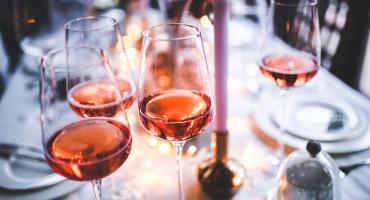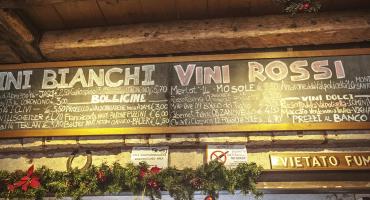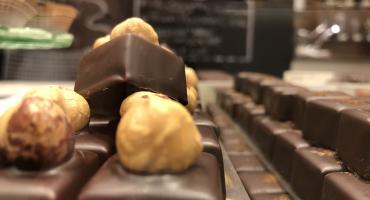It is common knowledge that Venice has for centuries been an authentic door of the interchange between the Far East and the West; this opens a series or arguments and a long walk backwards that plaits the history of art, religious gatherings and the presence of many communities in the city which enrich our culinary culture.
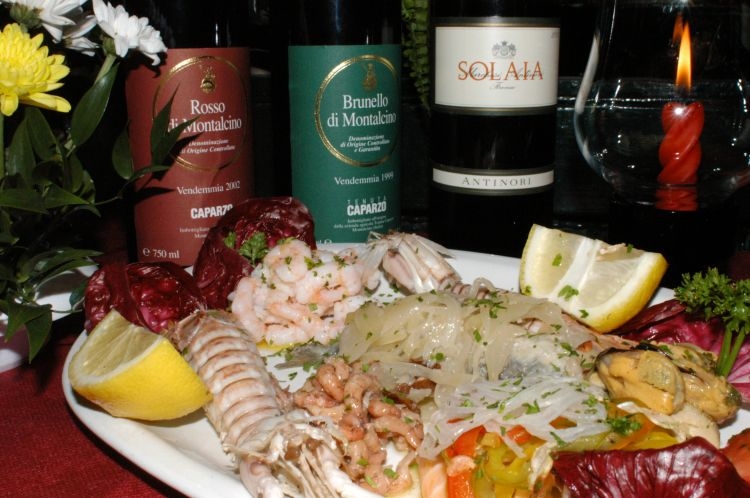 The pilgrims, who arrived to Venice from every part of Europe in the Ascension period ("Feast of La Sensa") in order to sail towards the Holy Land, used to get astounded by the quantity and the variety of stuff that could be found in this city of water.
The pilgrims, who arrived to Venice from every part of Europe in the Ascension period ("Feast of La Sensa") in order to sail towards the Holy Land, used to get astounded by the quantity and the variety of stuff that could be found in this city of water.
Admiration for a good management that guaranteed such great prosperity shone through from their chronicles – a prosperity which was noticed both from the well-stocked markets and warehouses such as barns of Newfoundland and Fontego.
Supplying with the flour justified the continuous conquests of the mainland that will shortly see Venice as the "queen of the land and the sea".
The conquest of the Orient leads Venice to get hold of the road of the spices, imposing these onto the markets of the present European countries.
Many products of oriental origin find their daily use, in this case the spices: ginger, cinnamon, nutmeg, cardamom, sugar etc..; their use, according to typically eastern characteristics, became almost exaggerated in the late medieval ages so to confuse the taste of food and also to cover unpleasant flavours; it continued less in the renaissance and we can still find it to this day, even if the amount is reduced.
Historic documents inform us that in 15th century Venetian warehouses used to get supplied yearly with about five thousand tons of spices which were unloaded from the ships coming from the Far Eastern ports; a large quantity of these spices remained in the city to increase the flourishing industry led by "wholesale apothecaries" who, using their secret recipes, prepared the famous "Veneto bags" and " Venetian spicery bags", sold at a very high price.
Great use of spices in the kitchen for six centuries is presented in a recipe by an unknown chef from 1400, and known to us by the name of "ginger chicken" where the quantity of spices used is good 750 grams.
Another important contamination of oriental origin of the Venetian cuisine is the Jewish one, very much spread in Venice due to the presence of a large community in the first ghetto in history.
Rice with raisins, “i cugoli” (gnocchi of breadcrumbs), goose salami and many others are a result of combination laid down by rigid prohibitions and religious obligations: like a custom to combine rice with various vegetables, introduction of meats of goose, duck and, later, turkey.
Amongst products of oriental origin, rice is the one that mostly characterises the Venetian cuisine. During medieval age it was one of the most expensive food and was very often sold in the "apothecaries" for medical use; as food, it was reduced almost to rice flour and used to thicken the soups.
 It was in 16th century that rice became the king of the Venetians' tables and it started to be part of the Venetian gastronomy: "risi e bisi" (peas from the lagoon gardens) is a dish of the most important holiday in Venice, St Mark's Day; and Carlo Goldoni, in one of his comedies, talks about "Cento risi cola quagietta".
It was in 16th century that rice became the king of the Venetians' tables and it started to be part of the Venetian gastronomy: "risi e bisi" (peas from the lagoon gardens) is a dish of the most important holiday in Venice, St Mark's Day; and Carlo Goldoni, in one of his comedies, talks about "Cento risi cola quagietta".
In fact, a tourist in Venice, can taste a variety of risottos and soups with rice and he will get surprised by delicate tones these particular dishes will offer.
Traditional Venetian cuisine is actually a very simple cuisine because its basic ingredients, preparation methods and cooking times were simple, but at the same time it is a complex cuisine because it could be said that it followed events of a thousand year history of St Mark's city, with a language made of matchings, developments and flavours.
For example, in the Venetian tradition, there are dishes based on usage of residual products of butchery (liver, spleen, heart, nerves, tripe, etc…) as well as very elaborated others: "sopa coada", oyster soup, stuffed duck, all the sweet products etc…, some of which are used daily even today.
There are famous and notable banquets offered by Serenissima in occasion of arrival of princes and foreign ambassadors to the city and there are also the most important holidays after which remained proverbial the use of “piron“ (fork) brought from Byzantium and the famous "sugar triumphs" (food then unknown in Europe which used honey only), sugar that Venice imported from Turkey and Candia, having the monopoly of it and imposing it onto the markets.
Closely linked to the evolution of economic history of Venice is also the use of preserved products and the related preservation techniques.
In the markets, at the "lagoon-men", it was possible to find sausages as well as meats of sturgeon, tuna and dried salted cod: explanation of usage of such products is to be found in the habits of Venetians to bear sea travel that could last even a year and during which decaying of food items had to be avoided.
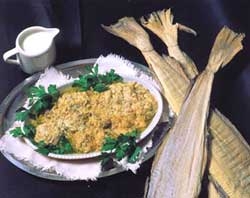 From that, the most known Venetian recipe of "fish in sauce" or precisely "sardines in sauce" has its origins. This sweet-and-sour that arrived from Constantinople, mixes fish with onions, sultanas, pine-seeds and vinegar.
From that, the most known Venetian recipe of "fish in sauce" or precisely "sardines in sauce" has its origins. This sweet-and-sour that arrived from Constantinople, mixes fish with onions, sultanas, pine-seeds and vinegar.
Apart from having a special flavour, it could be brought on sailing voyages and consumed for days with "bussolai" (long lasting biscuits) and it is said even today that the best sardines in sauce need to be done three days before.
However, fish is obviously the nourishment basis for a sea city; still, the Venetian table doesn't disdain game meat. "To go bird-catching" in lagoon had already been medieval habit and there are many pictorial testimonies on hunting in the valley.
Hunted game was cooked on the spit and filled with herbs like it is done today: small birds (like quails) were put on spits alternated with pieces of pork meat, bacon or lard and accompanied by tender polenta; it's the origin of the famous “polenta e osei“.
Polenta was already in use by Mediterranean populations and ancient Romans and its ingredients were minced broad beans and spelt; but true and real polenta began with corn imported from America and was later cultivated in Veneto on the large scale.
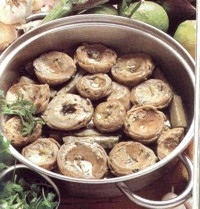 Culinary revolution introduced by Venetians was noticed also in the customs of having main courses of fruit and vegetables, many of which initially came from the Middle East, like cauliflower, spinach and artichokes and whose production then, like nowadays, was supplied from abundant and varied cultivation of our islands in the lagoon; how not to remember “castraure” from the island of S. Erasmo (the first small artichokes cut in the beginning of spring) and the very sough-after lagoon first produce, “bruscandoli” (young sprouts of hops) that were used for preparation of, at the very least, a sublime risotto. All these first produce and others exhibit themselves on the stalls of the historic Rialto market: a feast for eyes and palate, where you can find everything from fruit and vegetable products to fish, cheeses, bread and cakes.
Culinary revolution introduced by Venetians was noticed also in the customs of having main courses of fruit and vegetables, many of which initially came from the Middle East, like cauliflower, spinach and artichokes and whose production then, like nowadays, was supplied from abundant and varied cultivation of our islands in the lagoon; how not to remember “castraure” from the island of S. Erasmo (the first small artichokes cut in the beginning of spring) and the very sough-after lagoon first produce, “bruscandoli” (young sprouts of hops) that were used for preparation of, at the very least, a sublime risotto. All these first produce and others exhibit themselves on the stalls of the historic Rialto market: a feast for eyes and palate, where you can find everything from fruit and vegetable products to fish, cheeses, bread and cakes.
Actually, all the cake sector was very important that it necessarily needs to take into account cosmopolitan Venetian ambient.
In fact, coffee imported from Turkey appeared in 1550 and very much later, in 1700, there was chocolate and consumption of Austrian cakes such as chifel (crescent-shaped bun), krapfen (doughnut), strudel, sacher cake etc..
Coffee and chocolate immediately take us to the famous historic Caffè Florian and the plays by Goldoni: in fact, the first coffee shops were established towards the end of 1500 in St Mark's Square where coffee is recognised as means of culture and socialising.
Venetian desserts don’t' finish here, they continue with “caramel“, caramelised fruit, biscuits (like most famous “baicoli“), “fugasse”,“fritole“ and carnival “galani”, “buranelli”(typical biscuits from the island of Burano) and many more; everything was always washed down with precious oriental wines like the wine from Cyprus, raisin wines and malmsey.
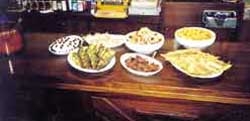 Once upon a time a wine shop/bar was in "furatole" (taverns blackened with smoke from fireplaces) and in "malvasie" (shops selling precious wines) where the famous and very present “spritz” used to be served – it's name can be traced back to Habsburg reminiscences (house wine + campari or aperol and soda water garnished with an olive or slice of orange). Fostered “furatole” and “malvasie”,“bacari” where we can taste appetising “cicheti” (small snacks) always accompanied by a shade of good wine (expression that derived from the fact that the street wine sellers went into the shade of the bell tower of St Mark to refresh the passers-by…) are our adored.
Once upon a time a wine shop/bar was in "furatole" (taverns blackened with smoke from fireplaces) and in "malvasie" (shops selling precious wines) where the famous and very present “spritz” used to be served – it's name can be traced back to Habsburg reminiscences (house wine + campari or aperol and soda water garnished with an olive or slice of orange). Fostered “furatole” and “malvasie”,“bacari” where we can taste appetising “cicheti” (small snacks) always accompanied by a shade of good wine (expression that derived from the fact that the street wine sellers went into the shade of the bell tower of St Mark to refresh the passers-by…) are our adored.
A winning aspect of the Venetian gastronomy is the habit to meet each other and eat in many osterie (taverns) or bacari.
Gastronomic route lived by Venice through centuries is exceptional and very rich and it becomes even more precious like a factor of cultural transmission, in fact, in Venice can be found the first cookery books that used to be printed together with musical scores and other books in many languages, recognising in Venice the capital of printing with the presence of most important ones in this sector (amongst which Aldo Manuzio).
Triumphs of Venetian cuisine were so extraordinary that can be found expressed in the most beautiful and immense renaissance oils, amongst which there is a very famous "Feast in the House of Levi" or "The Marriage at Cana" by Paolo Veronese where the richness and the variety of the table of an elegant Venetian ambient is expressed with such wealth of details and colours in order to forget specificity of the religious subject.
To tell the truth, Feast in the house of Levi (kept in the Accademia gallery), was originally a last supper but Veronese, to avoid the wraths of inquisition, brilliantly transformed the Marriage into the House of Levi, and changing the painting's title he saved his life…
Some Venetian recipes...
Turkish rice pudding
Ingredients: ¾ lt. of milk, 100 gr. of rice, 50 gr. of sugar, ½ vanilla stick, 50 gr. of sultanas, 30 gr. of pine-seeds, butter and salt.
Heat up the milk with vanilla; shortly before it starts to boil, pour the rice and stir continuously so that it doesn't stick together. When it's half-cooked add salt, sugar and butter; finally add the dried fruit and pine-seeds. Pour into buttered moulds and let it cool. Before serving, put it in a hot oven.
Bigoli in salsa (Venetian spaghetti with sauce)
Ingredients: one onion, one garlic clove, extra virgin olive oil, one tin of anchovies (or salted sardines)
Thinly slice onion and garlic, making them wilt in oil and very little water (onion needs to remain white). Get rid of salt from sardines by washing them under running water (or use anchovies from tin without conserving oil). Cut them all in small pieces and let them cook with onions for 5 minutes together with an added hot chilly paper, which will be removed in the end. Finally, a dash of white wine; when wine is evaporated, pour onto spaghetti, cooked al dente and strained well.
Sarde in saor (Sardines in sauce)
After having fried the sardines (not too much, possibly still white a bit), arrange them on a plate alternating them with “sauce”. “Sauce” is prepared by cutting one onion per person and cooking it “in white” (that means slowly without browning it) in some oil and three spoons of vinegar; sultanas and pine-seeds also get added and a hot chilli pepper, if you like. Layers: sardines plus sauce, must be pressed a bit and left to rest for few hours before being consumed.
Risi e bisi (Rice with peas)
Ingredients: 300 gr. of Violone-type rice, 1 kg. of fresh peas, 50 gr. of bacon, one onion, a spoonful of shredded parsley, 1 lt. of meat stock, 3 spoons of grated cheese, salt and pepper.
Shell the peas and fry them immediately with bacon, onion and shredded parsley. Add a couple of ladles of stock and season with salt on a high flame. Then pour the remaining stock, bring to boil, add rice and let it cook, stirring often. Towards the end of cooking, add grated cheese and pepper. Serve it after having left rice to rest for few minutes.
Risi coll’ua (Rice with sultanas)
Ingredients: 400 gr. of rice, 100 gr. of Malaga-type sultanas, 1 dl. of oil, 2 garlic cloves, a spoonful of shredded parsley, 50 gr. of grated parmesan, salt.
Let garlic and shredded parsley turn golden in oil, pour rice and, stirring it often bring to cook by adding, when needed, a bit of boiling water. Some seconds before finishing with cooking, join sultanas and immediately after, the parmesan; serve hot.
Salsa alla cacciatora (cacciatore sauce)
Mix together one glass of white wine, as much stock, juice of one lemon, a handful of breadcrumbs, two spoons of oil, some shredded parsley and onions, a bay leaf, salt, pepper and nutmeg; let everything boil.
Practical advice and useful information:
Eating places
- Rialto Market
- Caffè Florian
- Accademia Galleries (Paolo Veronese)
- Ca’ Rezzonico (Pietro Longhi and paintings of hunting in the valley)
- Museum Correr (cookery books)
Bacari, ostarie and cake shops (for a snack or a delicious pasta on the go)
- Alla Vedova
- Alla Botte
- Ai Do Mori
- Ae do spade
- Al Mascaron
- Da Codroma
- Cantina agli Schiavi
- Alla Patatina
- Ballarin
- Boscolo
- Bakery al Ghetto
- Rosa Salva
- Tonolo
- Harry’s dolci
Coffee shops
- Caffè del Doge (Ruga Rialto)
- Antica Torrefazione (S. Leonardo)
We also recommend the new chocolate shops in Campo S. Tomà and in Fondamenta del Liceo Marco Polo (close to Accademia).

